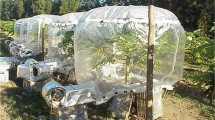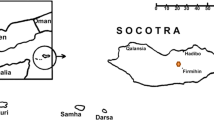Abstract
The heat balance method was evaluated in detail for its use in older, mature grapevines with stems of 35 – 45 mm in diameter. Dye colouring of the xylem vessels revealed that even 21 year old grapevines did not show any development of heartwood and that xylem vessels of that age still have the capacity to transport water.
A comparison of weight loss of potted vines on a balance and sap flow measurements demonstrated that the heat balance system reflected rapid changes in flow rate without any time delay. However, since even 20 year old xylem vessels of grapevines have the capacity to conduct water, the heater band was not able to heat the sap in all year rings evenly. Apparently, at low flow rates this effect was small and sap flow was calculated correctly. With increasing flow rates large thermal heterogeneities developed upsetting the calculation of the heat balance and mass flow. Consequently, actual sap flow was overestimated by 50 to 100% at high flow rates. This could be attributed to thermal gradients in these relatively thick stems excluding the use of this technique for measurements of long term as well as short term water use patterns in older grapevines.
Similar content being viewed by others
References
Baker J M and Nieber J L 1989 An analysis of the steady-state heat balance method for measuring sap flow in plants Agric. Forest Meteorol. 48, 93–109.
Buwalda J G and Smith G S 1990 Acquisition and utilization of carbon, mineral nutrients, and water by the kiwifruit vine. Hort. Rev. 12, 307–347.
Eastham J and Gray S A 1998 A preliminary evaluation of the suitability of sap flow sensors for use in scheduling vineyard irrigation. Am. J. Enol. Vitic. 49, 171–176.
Ewers F W 1985 Xylem structure and water conduction in conifer trees, dicot trees, and lianas. Int. Assoc. Wood Anat. Bull. 6, 309–317.
Ewers F W and Fisher J B 1991 Why vines have narrow stems-histological trends in Bauhinia (Fabaceae). Oecologia 88, 233–237.
Fichtner K and Schulze E-D 1990 Xylem water flow in tropical vines as measured by a steady state heating method. Oecologia 82, 355–361.
Green S R and Clothier B E 1988 Water use of kiwifruit vines and apple trees by the heat-pulse technique. J. Exp. Bot. 39, 115–123.
Grime V L, Morison J I L and Simmonds L P 1995a Including the heat storage term in sap flow measurements with the stem heat balance method. Agric. Forest Meteorol. 74, 1–25.
Grime V L, Morison J I L and Simmonds L P 1995b Sap flow measurements from stem heat balances: a comparison of constant with variable power methods. Agric. Forest Meteorol 74, 27–40.
Ham J M and Heilman I L 1990 Dynamics of a heat balance stem flow gauge during high flow. Agron. 1. 82, 147–152.
Hofäcker W 1976 Untersuchungen über den Einfluß wechselnder Bodenfeuchte auf Fruchtbarkeit, Beerenwachstum, Ertrag und Mostgewicht bei Reben. Wein Wissenschaft 31, 1–8.
Lascano R J, Baumhardt R L and Lipe W N 1992 Measurement of water flow in young grapevines using the stem heat balance method. Amer. J. Enol. Vitic. 43, 159–165.
Richards D 1983 The grape root system. Hort. Rev. 5, 127–168.
Sakuratani T 1981 A heat balance method for measuring water flux in the stem of intact plants. J. Agric. Meteorol. 37, 9–17.
Shackel K A, Johnson R S, Medawar C K and Phene C 1992 Substantial errors in estimates of sap flow using the heat balance technique on woody stems under field conditions. J. Amer. Soc. Hort. Sci. 117, 351–356.
Steinberg S, Bavel C H M v and McFarland M J 1989 A gauge to measure mass flow rate of sap in stems and trunks of woody plants. J. Amer. Soc. Hort. Sci. 114, 466–472.
Weibel F P and Boersma K 1995 An improved stem heat balance method using analog heat control. Agric. Forest Meteorol. 75, 191–208.
Weibel F P and Vos I A d 1994 Transpiration measurements on apple trees with an improved stem heat balance method. Plant Soil 166, 203–219.
Yunusa I A M, Walker R R and Blackmore D H 1997a Characterisation of water use by Sultana grapevines (Vitis vinifera L.) on their own roots or on Ramsey rootstock drip-irrigated with water of different salinities. Irrig. Sci. 17, 77–86.
Yunusa I A M, Walker R R and Guy I R 1997b. Partitioning of seasonal evapotranspiration from a commercial furrow-irrigated Sultana vineyard. Irrig. Sci. 18, 45–54.
Zimmermann M H 1983 Xylem Structure and the Ascent of Sap. Springer Verlag, Berlin, Heidelberg, New York.
Author information
Authors and Affiliations
Rights and permissions
About this article
Cite this article
Braun, P., Schmid, J. Sap flow measurements in grapevines (Vitis vinifera L.) 1. Stem morphology and use of the heat balance method. Plant and Soil 215, 39–45 (1999). https://doi.org/10.1023/A:1004756002983
Issue Date:
DOI: https://doi.org/10.1023/A:1004756002983




